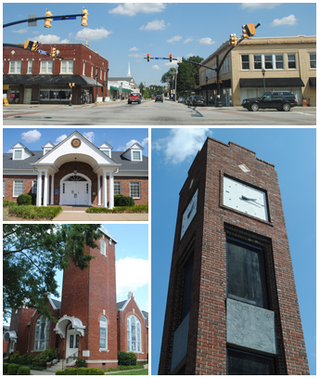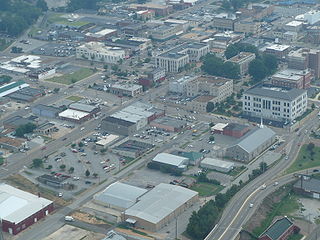Related Research Articles

Louisville is the most populous city in the Commonwealth of Kentucky, sixth-most populous city in the Southeast, and the 27th-most-populous city in the United States. By land area, it is the country's 24th-largest city, although by population density, it is the 265th most dense city. Louisville is the historical county seat and, since 2003, the nominal seat of Jefferson County, on the Indiana border.

Gilbert is a town in Maricopa County, Arizona, United States. Located southeast of Phoenix, Gilbert is home to 288,128 residents. It is the fifth-largest municipality in Arizona. Nearly a third of Gilbert residents are under the age of 18. As Gilbert approaches buildout, the population is expected to reach 330,000.

Simpsonville is a city in Greenville County, South Carolina, United States. It is part of the Greenville, SC Metropolitan Statistical Area. The population was 23,354 at the 2020 census, up from 18,238 in the 2010 census. Simpsonville is part of the "Golden Strip", along with Mauldin and Fountain Inn, an area which is noted for having low unemployment due to a diversity of industries including H.B. Fuller, KEMET, Sealed Air and Milliken. It is the 23rd-most populous city in South Carolina.
City Quality of Life Indices are lists of cities that are ranked according to a defined measure of living conditions. In addition to considering the provision of clean water, clean air, adequate food and shelter, many indexes also measure more subjective elements including a city's capacity to generate a sense of community and offer hospitable settings for all, especially young people, to develop social skills, a sense of autonomy and identity.
Crime in St. Louis includes an overview of crime both in the city of St. Louis and in the Greater St. Louis metropolitan area. Crime in the city increased from the 1960s through the early 1990s as measured by the index crime rate. Despite decreasing crime, rates of violent crime and property crime in both the city and the metropolitan area remain higher than the national metropolitan area average. In addition, the city of St. Louis consistently has been ranked among the most dangerous cities in the United States. As of April 2017, St. Louis has the highest murder rate in America. At the end of 2017, St. Louis metropolitan had 205 murders, 159 of which were within the city limits. In 2018, the new Chief of Police, John Hayden said two-thirds (67%) of all the murders and one-half of all the assaults are concentrated in a triangular area in the north part of the city.
The following table is based on Federal Bureau of Investigation Uniform Crime Reports statistics.
The following table is based on Federal Bureau of Investigation Uniform Crime Reports statistics.
The following table is based on Federal Bureau of Investigation Uniform Crime Reports statistics.
As of 2018 Detroit had the fourth highest murder rate among major cities in the United States after St. Louis and Baltimore and the 42nd highest murder rate in the world. The rate of robberies in Detroit declined by 67% between 1985 and 2014 while the rate of aggravated assaults increased. As a whole, the city's crime rate has decreased considerably from its 1980s peak.

The Jackson, Tennessee Metropolitan Statistical Area, as defined by the United States Census Bureau, is an area consisting of four counties - Madison, Chester, Gibson, Crockett - in western Tennessee, anchored by the city of Jackson. As of the 2020 census, the MSA had a population of 180,509.
America's Safest and Most Dangerous Cities is a publication issued annually by CQ Press, a division of Congressional Quarterly Inc., that ranks American cities on the basis of safety and crime. According to the publisher, the rankings are based upon statistics submitted by cities to the Federal Bureau of Investigation (FBI) which are then published by the FBI online, as part of the Bureau's Uniform Crime Reporting (UCR) program. Recently, the ranking has been criticized by several organizations, including The American Society of Criminology (ASC), Criminal Justice Journalists, and The United States Conference of Mayors as well as the FBI.
Crime in Atlanta, Georgia is above the national median and has been a major problem for the city since the middle 20th century.
In 2016 there were 91,115 crimes reported in the U.S. state of Mississippi, including 238 murders. In 2017–2018 the violent crime rate dropped 8%.
In 2010, 356 people were murdered in the U.S. state of Tennessee. In 2009 and 2010, Tennessee had the highest rate of violent gun crime of any US state, although less than that of Washington D.C. Tennessee ranked highest in the nation for the rate of aggravated assaults with a firearm, and ranked fifth-worst in robberies.
The history of St. Louis, Missouri from 1981 to the present has been marked by city beautification and crime prevention efforts, a major school desegregation case, and gentrification in its downtown area. St. Louis also continues to struggle with crime and a declining population, although some improvement has been made in both of these aspects.
In 2014, the city of Memphis ranked eleventh in violent crimes for major cities around the U.S. In 2006, Memphis led the nation in number of violent crimes. In 2001, 2005, and 2007, Memphis ranked second most dangerous in the nation among cities with a population over 500,000. It also ranked as most dangerous in 2002. There are approximately 182 gangs in Memphis, Tennessee with 8,400 gang members in the county.
Crime in Flint, Michigan, has been a serious issue for more than a decade. Since the late-2000s, Flint has consistently ranked among the most violent cities in the United States. Law enforcement in Flint is primarily the responsibility of the Flint Police Department, which is often assisted by the Genesee County Sheriff's Department and the Michigan State Police, which maintains a post in adjacent Flint Township that serves all of Genesee County, as well as the Genesee County Parks and Recreation Commission Police and the campus police departments of the University of Michigan–Flint, Kettering University, and Mott Community College.

AreaVibes is a data analytics and real estate company based in Toronto, which provides clients with demographic data and analysis focused on real estate in American and Canadian cities.
Camden, New Jersey once had a national reputation for its violent crime rates, although recent years have seen a significant drop in violent crime, with 2017 seeing the lowest number of homicides in three decades.
References
- ↑ "Uniform Crime Reports", FBI Official Website
- ↑ "Criminologists Condemn City Crime Rankings", November 16, 2007, PR Newswire, accessed October 2, 2009
- 1 2 Elena Temple, "The U.S. Conference of Mayors Challenges City Crime Rankings", PR Newswire, November 18, 2007, accessed October 2, 2009
- ↑ St. Louis Today.com Archived November 19, 2007, at the Wayback Machine